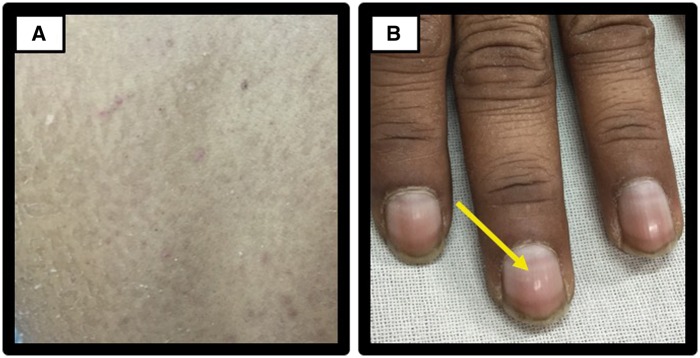A 40-year-old male presented with 4 weeks’ history of numbness with painful paraesthesias in limbs. The paraesthesias (tingling and gnawing pain) and numbness started distally in hands and feet, almost simultaneously, and reached up till wrists and mid legs over 2 weeks. At this time, he noticed imbalance on walking which worsened in dark and some difficulty in gripping objects Examination revealed mild hand grip weakness, generalized areflexia, pansensory loss in glove and stocking distribution and sensory ataxia. He had antecedent fever, loose stools, transaminitis, right pleural effusion 2 weeks before the neurological symptoms, which recovered in 5 days. He had history of intake of indigenous medicines (herbal) during this febrile episode. Electrophysiology revealed demyelinating sensorimotor polyradiculoneuropathy with conduction blocks. Cerebrospinal fluid examination revealed albuminocytologic dissociation. Over the next 2 weeks he developed profound distal weakness, desquamating rash over trunk and limbs, rain drop pigmentation (Figure 1A) and Mees’ lines (Figure 1B). 24-h urine arsenic levels were 405.2 g/l. Considering a diagnosis of arsenic induced subacute demyelinating polyradiculoneuropathy, he was treated symptomatically for pain. The neuropathy stabilized after 6 weeks of onset.
Figure 1.
(A) Rain drop pigmentation seen over posterior aspect of trunk. (B) Mees’ lines seen in fingernails.
In India ∼80% of the population uses herbal medicine products.1 Studies have shown that these preparations contain significant amount of heavy metals like arsenic, lead, mercury and cadmium, well above the safety levels.2 The high content is either due to the practice of deliberately combining herbs with metals, minerals and gems for therapeutic benefit, or due to contamination. Traditional medicines from various other countries including China, Middle East, Africa, Mexico and Malaysia have also been shown to be adulterated with heavy metals, exposing the users to potential toxicity.2
Arsenic toxicity can be acute or chronic, and presents with multisystem involvement. The neurological manifestations of acute/subacute exposure include rapidly ascending severe weakness similar to Guillain Barre’ syndrome, seizures and encephalopathy.3 Chronic arsenic toxicity manifests neurologically as a distal symmetrical axonal painful polyneuropathy. Characteristic skin lesions (rain drop pigmentation and hyperkeratosis) along with Mees’ lines are important clues to the diagnosis of significant arsenic exposure.3 Mees’ lines are prominent transverse white lines in finger or toe nails due to arsenic deposition in keratin rich tissues. They take some 3–6 weeks to manifest. The above mentioned skin changes are usually present in chronic arsenic toxicity, but can rarely be seen after acute or subacute exposures.
To summarize, in a patient presenting with a peripheral neuropathy, the presence of characteristic skin and nail changes, multisystem involvement and history of exposure to indigenous or herbal medicines are important pointers that should arouse suspicion and prompt a screening for heavy metal toxicity especially arsenic.
Acknowledgments
Conflict of interest: None declared.
References
- 1.Gogtay NJ, Bhatt HA, Dalvi SS, Kshirsagar NA. The use and safety of non-allopathic Indian medicines. Drug Saf 2002; 25:1005–1019. [DOI] [PubMed] [Google Scholar]
- 2.Saper RB, Kales SN, Paquin J, Burns MJ, Eisenberg DM, Davis RB, et al. Heavy metal content of Ayurvedic herbal medicine products. Jama 2004; 292:2868–2873. [DOI] [PubMed] [Google Scholar]
- 3.Ratnaike RN. Acute and chronic arsenic toxicity. Postgrad Med J 2003; 79:391–396. [DOI] [PMC free article] [PubMed] [Google Scholar]



